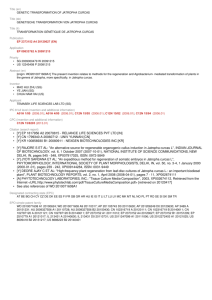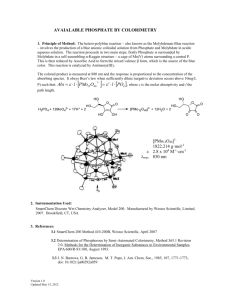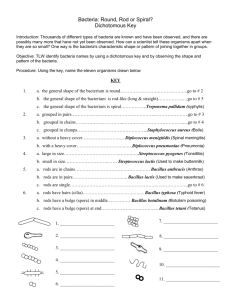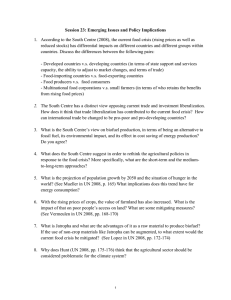Document 14093822
advertisement
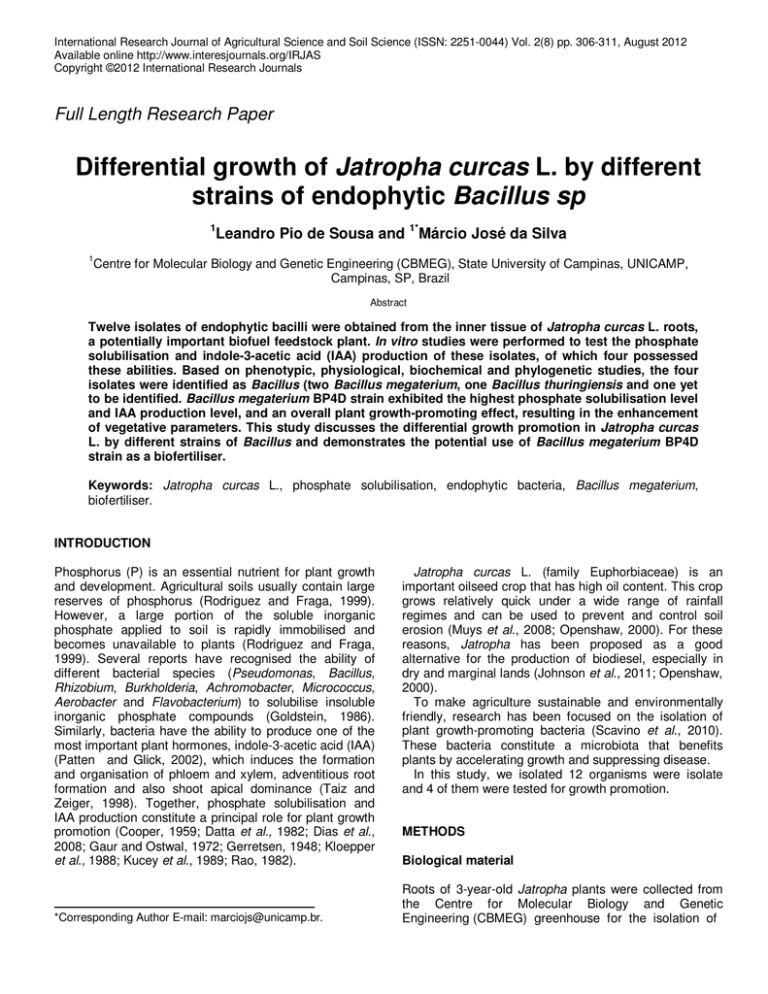
International Research Journal of Agricultural Science and Soil Science (ISSN: 2251-0044) Vol. 2(8) pp. 306-311, August 2012 Available online http://www.interesjournals.org/IRJAS Copyright ©2012 International Research Journals Full Length Research Paper Differential growth of Jatropha curcas L. by different strains of endophytic Bacillus sp 1 Leandro Pio de Sousa and 1*Márcio José da Silva 1 Centre for Molecular Biology and Genetic Engineering (CBMEG), State University of Campinas, UNICAMP, Campinas, SP, Brazil Abstract Twelve isolates of endophytic bacilli were obtained from the inner tissue of Jatropha curcas L. roots, a potentially important biofuel feedstock plant. In vitro studies were performed to test the phosphate solubilisation and indole-3-acetic acid (IAA) production of these isolates, of which four possessed these abilities. Based on phenotypic, physiological, biochemical and phylogenetic studies, the four isolates were identified as Bacillus (two Bacillus megaterium, one Bacillus thuringiensis and one yet to be identified. Bacillus megaterium BP4D strain exhibited the highest phosphate solubilisation level and IAA production level, and an overall plant growth-promoting effect, resulting in the enhancement of vegetative parameters. This study discusses the differential growth promotion in Jatropha curcas L. by different strains of Bacillus and demonstrates the potential use of Bacillus megaterium BP4D strain as a biofertiliser. Keywords: Jatropha curcas L., phosphate solubilisation, endophytic bacteria, Bacillus megaterium, biofertiliser. INTRODUCTION Phosphorus (P) is an essential nutrient for plant growth and development. Agricultural soils usually contain large reserves of phosphorus (Rodriguez and Fraga, 1999). However, a large portion of the soluble inorganic phosphate applied to soil is rapidly immobilised and becomes unavailable to plants (Rodriguez and Fraga, 1999). Several reports have recognised the ability of different bacterial species (Pseudomonas, Bacillus, Rhizobium, Burkholderia, Achromobacter, Micrococcus, Aerobacter and Flavobacterium) to solubilise insoluble inorganic phosphate compounds (Goldstein, 1986). Similarly, bacteria have the ability to produce one of the most important plant hormones, indole-3-acetic acid (IAA) (Patten and Glick, 2002), which induces the formation and organisation of phloem and xylem, adventitious root formation and also shoot apical dominance (Taiz and Zeiger, 1998). Together, phosphate solubilisation and IAA production constitute a principal role for plant growth promotion (Cooper, 1959; Datta et al., 1982; Dias et al., 2008; Gaur and Ostwal, 1972; Gerretsen, 1948; Kloepper et al., 1988; Kucey et al., 1989; Rao, 1982). *Corresponding Author E-mail: marciojs@unicamp.br. Jatropha curcas L. (family Euphorbiaceae) is an important oilseed crop that has high oil content. This crop grows relatively quick under a wide range of rainfall regimes and can be used to prevent and control soil erosion (Muys et al., 2008; Openshaw, 2000). For these reasons, Jatropha has been proposed as a good alternative for the production of biodiesel, especially in dry and marginal lands (Johnson et al., 2011; Openshaw, 2000). To make agriculture sustainable and environmentally friendly, research has been focused on the isolation of plant growth-promoting bacteria (Scavino et al., 2010). These bacteria constitute a microbiota that benefits plants by accelerating growth and suppressing disease. In this study, we isolated 12 organisms were isolate and 4 of them were tested for growth promotion. METHODS Biological material Roots of 3-year-old Jatropha plants were collected from the Centre for Molecular Biology and Genetic Engineering (CBMEG) greenhouse for the isolation of Sousa and Silva 307 endophytes. Jatropha seeds maintained in the Germplasm Bank of the Agronomic Institute of Campinas (IAC) were selected for the plant growth-promotion experiment. ethanol. The DNA was dried, eluted in 50µL of sterile water and preserved at -20°C. 16S rDNA gene amplification, phylogenetic analyses sequencing and Root samples and bacterial isolation Roots were collected from 3-year-old Jatropha curcas L. plants cultivated in the greenhouse. Root surfaces were disinfected with a 5 min 70% ethanol wash, a 2 min 5% sodium hypochlorite wash and two rinses in sterile distilled water. Samples were homogenised in 10 mL of sterile phosphate-buffered saline, and serial dilutions were plated on Luria-Bertani (LB) medium and incubated for 3 days at 30°C. Each colony was purified according to morphological characteristics and grown in CIRCLEGROW® Medium (ICN Biomedicals, Inc., Solon, Ohio, USA) with shaking (150rpm) at 28°C for 12h. After purification, each colony were heat-treated (90oC for 10 min) and only spore-forming bacteria were selected and preserved in CIRCLEGROW® Medium containing 12% glycerol at -70°C. Amplification of 16S rDNA gene sequences was performed using PCR with the universal primers 338F and 1046R as described by Antonio et al., (2011). The PCR products were sequenced using the Big Dye terminator v 3.1 kit and an automated DNA capillary sequencer (ABI PRISM 3700 DNA Analyzer, Applied Bio systems). All PCR products were 5′-sequenced using the 338F primer (5′-ACTCCTACGGGAGGCAGCAG-3′) and 3’-sequenced using the 1046R primer (5’AGGTGNTGCATGGCTGTCG-3’). Analyses of the sequences were performed using BLASTn against the Nucleotide (NT) Database. The partial 16S rDNA fragment was sequenced and deposited at GenBank (NCBI). CG-FAME identification Screening for phosphate solubilisation and auxin production -1 Strains were cultivated in solid medium containing 4g.L MgCl2.6H2O, 0.25g.L-1.MgSO4.7H2O, 0.2 g.L-1KCl, 0.1 g.L-1 (NH4)2SO4, 5 g.L-1 Ca3(PO4)2 and 10g.L-1.glucose, for phosphate solubilisation screening and incubated at 30°C for seven days. The ability to solubilise phosphate was measured using the formation of halos around colonies (de Freitas, 1997), and quantification was performed using the molybdenum blue method as described by Sa et al., (2005). For IAA production screening, strains were cultivated on Tryptic Soy Agar plates supplemented with NH4Cl2 (10 mmol.L-1) and L-tryptophan (100µg.mL-1). The evaluation of IAA production was performed as described by Dias et al., (2008). DNA extraction Four isolates which had positive results were grown in CIRCLEGROW® Medium with shaking at150rpm at 28°C for 12h, followed by centrifugation at 2,200g for2 min, and the supernatant was discarded. The pellets were resuspended in GTE buffer (Glucose 20%, EDTA 0.5M, Tris-HCl 1M, pH 7.9) and treated with 2µL of RNAse (10µg.uL-1), followed by NaOH (4mol.L-1)/SDS (10%) and KOAc (3mol.L-1). The samples were incubated at 80°C for 30 min and centrifuged for 5 min. The supernatants were transferred into microcentrifuge tubes, and the DNA was precipitated with isopropanol and washed with 70% FAME identification was performed using gas chromatography as described by Dias et al., (2008). An identification report was prepared using the Microbial Identification System Software (Sherlock TSBA40 library, MIDI Inc., Newark, DE, USA) according to the manufacturer’s specifications. Preparation treatment of bacterial suspension and seed The bacterial strains used for the inoculation of Jatropha seeds were grown in CIRCLEGROW® Medium for 24h at 28°C. The cells were collected and washed twice with phosphate buffer (pH 7.0). The bacterial concentration used for inoculation was adjusted to 108cells.mL−1 in phosphate buffered saline (PBS). The seeds were treated with 5% sodium hypochlorite for 3 min and washed twice with sterile water. Seed bacterisation was performed as described by Desai et al., (2007). The plant growth-promotion greenhouse experiment in a Treated seeds were germinated on plastic tubes (10cm high and 7cm in diameter) containing sandy loam soil and were watered regularly. Plants from all treatment groups were maintained in a greenhouse for 40 days at temperatures from 28-35°C, a relative humidity of 5080% and a 16h photoperiod. Germination was checked every day. The number of leaves, the shoot and root 308 Int. Res. J. Agric. Sci. Soil Sci. Table 1. Screening for phosphate solubilisation and IAA production Isolate BP1D BP2D BP3D BP4D BP5D BP6D BP7D BP8D NFP1D NFP2D NFP3D NFP4D -1 P-solubilisation (µg.ml ) 4.4± 1.4 10.1±2.4 Negative 15.3 ±1.3 Negative 10.1±2.4 Negative Negative Negative Negative Negative Negative -1 IAA production (µg.ml ) Negative 1.9± 0.6 Negative 22± 0.6 Negative Negative Negative Negative Negative Negative Negative Negative Table 2. Identification of bacilli isolates using 16S rDNA sequencing Isolate BP1D BP2D BP4D BP6D GenBank Number JN903950 JN903951 JN903952 JN903953 Identity B. megaterium strain GYB16 Bacillus sp. SAP02_1 B. megaterium strain GYB16 B. thuringiensis strain GYS5 length, the shoot and root fresh weight and the shoot and root dry weight of the plant were analysed. The experiment was repeated twice. Statistical analyses All of the greenhouse data were suitably transformed and analysed in a completely randomised design and were subjected to analysis of variance. The mean values in each treatment were compared using least significant differences at 1% probability (P=0.01). Re-isolation of endophytic and rhizospheric bacteria Re-isolation of inoculated bacteria was performed according Dias et al., (2008) and Scavino et al., (2010) methodology. DNA extraction, sequencing and sequence analysis was done as described previously. Nucleotide sequence accession number The nucleotide sequences obtained were deposited in the GenBank Database under the accession number JN903950 – JN903953 Max score 1179 1114 1212 1171 Max identity 100% 98% 100% 99% RESULTS Isolation and characterisation of endophytes Based on colony morphology, twelve isolates were obtained from the inner tissue of Jatropha roots and screened for plant growth-promotion abilities. Four, out of the 12 isolates solubilised phosphate, two produced IAA and two had both abilities (Table 1). Identification of isolates The four bacterial isolates were Bacillus spp. (Table 2) with two B. megaterium, one B. thuringiensis and one Bacillus sp. Plant growth-promotion potential Seed inoculation with endophytic bacteria significantly enhanced growth in Jatropha compared with the control during the 40 days of sowing under certain parameters. The treatment of Jatropha seedlings with the BP4D significantly influenced all vegetative parameters when grown in pots under controlled conditions. The bacterised seedlings recorded 57 and 36% higher root and shoot Sousa and Silva 309 (A) 18 16 14 12 10 Lenght (cm) 8 Root 6 Shoot 4 2 0 Control BP4D BP1D BP2D BP6D Treatment (B) 7 6 5 4 Fresh Weight (g) Root 3 Shoot 2 1 0 Control BP4D BP1D BP2D BP6D Treatment (C) 3 2.5 2 Dry 1.5 Weight (g) Root Shoot 1 0.5 0 Control BP4D BP1D BP2D BP6D Treatment Figure 1. Vegetative parameters influenced by innoculum. Length (A), fresh weight (B) and dry weight (C) of root and shoot of Jatropha curcas L. lengths, respectively, as compared with the control (Figure 1). A similar 79 and 31.8% increase in the fresh root and shoot weights of Jatropha seedlings, respectively, was recorded as compared with the control; analogously, the shoot and root dry weights increased 221.4 and 84%, respectively. All strains were reisolated in rhizosphere and roots. DISCUSSION Few studies have examined the bacteria that live in association with Jatropha curcas L. and promoting its growth. Of those studies, most were implemented with rhizospheric bacteria (Chaitanya et al., 2011; Desai et al., 2007), and endophytes are yet to be studied with 310 Int. Res. J. Agric. Sci. Soil Sci. sufficient attention. In this study, we performed a screening that revealed four endophytic bacteria that produce IAA and solubilised phosphate. Dias et al., (2008) reported a large number of bacilli in inner plant tissues and demonstrated that Bacillus megaterium is one of the major phosphate-solubilising and IAAproducing bacteria. The capacity of Bacillus megaterium to colonise plant tissue and promote plant growth has been reported for several species (Elvira-Recuenco et al., 2000; Liu et al., 2006; Sturz et al., 1996) and for the first time, we report this relationship with Jatropha curcas L. Our tests illustrated that the Bacillus megaterium BP4D has potential abilities (IAA production and phosphate solubilisation) that promote plant growth and these multiple abilities increases the vegetative parameters significantly in comparison with other isolates which have only one of the abilities. BP4D strain showed high genetic similarity with BP1D strain, however BP1D did not produce IAA. Endophytes are known to promote plant growth by phosphate solubilisation (Verma et al., 2001), and inoculation with phosphate-solubilising Bacillus spp. can promote plant development (Yadav and Dadarwal, 1997). Similarly, endophytes can also promote plant growth by producing IAA (Mendes et al., 2007). Frequently, high scores for phosphate solubilisation do not correlate with high IAA production (Pereira et al., 2011), but in our study, we obtained an isolate that maximises both abilities. Liu et al., (2006) reported that Bacillus megaterium has the capacity to colonise maize with possible benefits for plant development; thus, we can speculate about the possible benefits of this bacterium for the growth of Jatropha, particularly for root development, which were observed in our experiment. The capacity to promote plant growth was observed in certain vegetative parameters such as the mass (dry and fresh) and the length of the roots. This increase can greatly benefit the plant because a well-developed root system enables plants to grow in environments lacking nutrients and water (Yang et al., 2009). Shoot growth did not reach the same level as root growth, but both exhibited significant changes that contributed to the development of inoculated plants. However, it is difficult to know which ability had a dominant effect on plant growth, a question that will require further study. All strains colonized rhizosphere and inner roots tissues including BP4D, therefore in this case phosphate solubilisation and IAA production works and both environments. Our results indicated that inoculation of Jatropha seeds an endophytic Bacillus megaterium BP4D which had multiple growths promoting abilities enhanced plant vitality, notably in the root system. This indicates the potential of this isolate to be used as a bio-fertilizer. Nevertheless, studies are still needed to better understand and optimise the endophytic relationship between Bacillus spp. and Jatropha for biotechnological applications. ACKNOWLEDGEMENTS We thank the technicians and researchers who contributed to this work, especially Daniela Stancato. We also thank Professor Daniela de Argollo Marques from the Agronomic Institute of Campinas for providing seeds used in this study and Professor Jorge Maurício Costa Mondego from the Agronomic Institute of Campinas for critical reading of the figures and for providing advice. This research was supported by the Molecular Biology of Plants Laboratory – Centre for Molecular Biology and Genetic Engineering (CBMEG), State University of Campinas (UNICAMP). REFERENCES Antonio M, Kwambana BA, Mohammed NI, Jeffries D, Barer M, Adegbola RA (2011). Differential effects of frozen storage on the molecular detection of bacterial taxa that inhabit the nasopharynx. BMC Clinical Pathology. 11:2-8. Chaitanya KJ, Kannepalli A, and Saraf M (2011). Isolation of Rhizobacteria from Jatropha curcas L. and characterization of produced ACC deaminase. J. Basic Microbiol. 52:285-295. Cooper R (1959). Bacterial fertilizers in the Soviet Union. Soils Fertilizers. 22:327–330. Datta M, Banish S, Dupta RK (1982). Studies on the efficacy of a phytohormone producing phosphate solubilizing Bacillus firmus in augmenting paddy yield in acid soils of Nagaland. Plant Soil. 69:365–373. de De Freitas JR, Banerjee MR, Germida JJ (1997). Phosphatesolubilizing rhizobacteria enhance the growth and yield but not phosphorous uptake in canola (Brassica napus L.). Biol. Fert. Soils. 24:358–364. Desai CS, Narayanaiah C, Kumari MSK, Reddy SS, Gnanamanickam G, Rashwara R, Venkateswarlu B (2007). Seed inoculation with Bacillus spp. improves seedling vigour in oil-seed plant Jatropha curcas L. Biol. Fert. Soils. 44: 229-234. Dias ACF, Costa FEC, Andreote FD, Lacava PT, Teixeira MA, Assumpção LC, Araújo WL, Azevedo JL, Melo IS (2008). Isolation of micropropagated strawberry endophytic bacteria and assessment of their potential for plant growth promotion.World J. Microbiol. Biotech. 25:189-195 . Elvira-Recuenco M, van Vuurde JWL (2000). Natural incidence of endophytic bacteria in pea cultivars under field conditions. Can. J. Microbiol. 46:1036-1041. Gaur AC, Ostwal KP (1972). Influence of phosphate dissolving Bacilli on yield and phosphate uptake of wheat crop. Indian. J. Exp. Biol. 10:393–394. Gerretsen FC (1948). The influence of microorganisms on the phosphate intake by the plant. Plant Soil. 1:51–81. Goldstein AH (1986). Bacterial solubilization of mineral phosphates. Am. J. Altern. Agri. 1:51–57. JohnsonTS, Eswaran N, Sujatha M (2011). Molecular approaches to improvement of Jatropha curcas Linn. as a sustainable energy crop. Plant Cell Rep. 30:1573-1591. Kloepper JW, Lifshitz K, Schroth MN (1988). Pseudomonas inoculants to benefit plant production. ISI Atlas Sci. Anim. Plant Sci. 1:60–64. Kucey RMN, Janzen HH, Leggett MM (1989). Microbially mediated increases in plant-available phosphorus. AdvAgron. 42:199-228. Liu X, Zhao H, Chen S (2006). Colonization of Maize and Rice Plants by Strain Bacillus megaterium C4. Curr. Microbiol. 55:186-190. Mendes R, Pizzirani-Kleiner AA, Araujo WL, Raaijmakers JM (2007). Diversity of cultivated endophytic bacteria from sugarcane: genetic Sousa and Silva 311 and biochemical characterization of Burkholderia cepacia complex isolates. Appl. Environ. Microbiol. 73:7259–7267. Muys B, Achten WMJ, Verchot L, Franken YJ, Mathijs E, SinghVP, Aerts R (2008). Jatropha bio-diesel production and use. Biom Bioen. 32:1063-1084. Openshaw K (2000). A review of Jatrophacurcas: an oil plant of unfulfilled promise. Biom. Bioen. 19:1-15. Patten CL, Glick BR (2002). Role of Pseudomonas putida Indoleacetic Acid in Development of the Host Plant Root System. Appl. Environ. Microbio. 68:3795-3801. Pereira GVM, Magalhães KT, Lorenzetii ER, Souza TP, Schwan RF (2011). A Multiphasic Approach for the Identification of Endophytic Bacterial in Strawberry Fruit and their Potential for Plant Growth Promotion. Microbial Eco. 63:405-417. Rao NSS (1982). Advances in agricultural microbiology. Studies in the Agricultura and Food Sciences. Ed. Butterworth Scientific. London, pp. 295–303. Rodriguez H, Fraga R (1999). Phosphate solubilizing bacteria and their role in plant growth promotion. Biotech. Advances. 17: 319-339. Sa T, Chung H, Park M, Madhaiyan M, Seshadri S, Song J, Cho H (2005). Isolation and characterization of phosphate solubilizing bacteria from the rhizosphere of crop plants of Korea. Soil Biol. Biochem. 37:1970-1974 . Scavino AF, Menes J, Ferrando L, Tarlera S (2010). Bacterial community analysis of the water surface layer from a rice-planted and an unplanted flooded field. Braz. J. of Microbiol. 41:411-419. Sturz A, Christie BR, Matheson BG, Nowak J (1996). Biodiversity of endophytic bacteria which colonize red clover nodules, roots, stems and foliage and their influence on host growth. Biol. Fertil. Soils. 25:13-19. Taiz L, Zeiger, E (1998). Plant Physiology. Massachusetts: Sinauer Associates, INC. Verma SC, Ladha JK, Tripathi AK (2001). Evaluation of plant growth promoting and colonization ability of endophyticdiazotrophs from deep water rice. J. Biotechnol. 91:127–141. Yadav KS, Dadarwal KR (1997). Phosphate solubilization and mobilization through soil microorganisms. Biotechnological approaches in soil microorganisms for sustainable crop production. Ed. Scientific Publishers. Jodhpur. pp 293–308 Yang J, Kloepper JW, Ryu C (2009). Rhizosphere bacteria help plants tolerate abiotic stress. Trends Plant Sci. 14:1-4.

